
St. John de Sahagun Church
Tigbauan, Iloilo
Twenty two kilometers away from Iloilo City lay the church of Tigbuan. The only church in the Philippines with Churriguesque-plateresque style until it was altered with an additional two unrelated towers. It was built in 1578 when Fr. Pedro Chirino was the parish priest and reconstructed during Fr. Fernando Comporendondo’s time. In the 1750’s this church is said to be the favorite destination of Spanish pilgrimage. It is made of sandstone and is built strongly to withstand the earthquake of the second quarter of 18th century. The old convent was destroyed in 1984.
The center masterpiece in the frontage was theoretically intended to be forcefully captivating in order to compensate for the lack of zoning. The columns are evocative of the Mexican Estipites tapering toward the capitals, edging the main arch entrance. The pilasters and spandrels are adorned with floral motifs. An angel with bent wings marks the keystone of the main arch.
On the first level is an Augustinian emblem of a heart-arrow and the Episcopal coat of arms occupies the middle of the cornice. A rectangular niche encasing San Nicholas de Tolentino marks the second story and topping it is another niche with the statue of Sto. Niño. It was noted that during the January 1883 Sto. Niño celebrations, the crowd overflowed from the church and loaded the plaza with more than 10,000 people from Negros and Panay.
Unlike its neighboring churches, only a handful of statue of saints can be found inside this church, only a wide array of carefully laden tile mosaics depicting bible stories (mostly parables) and the station of the cross that embellished the wall of this parish. The church’s altar is carefully laden mural in stones that is said to be one of the most beautiful altar murals in the region. Still baroque in style, this church had undergone renovations of its façade as the two belfries seemed to be out of place among the old stones seen from afar.
| 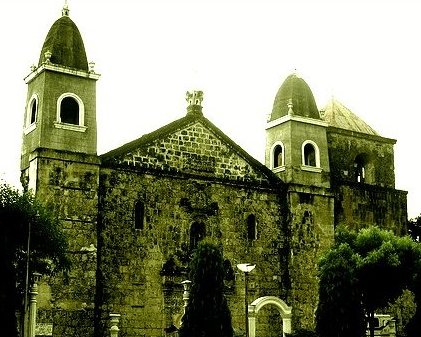 |
to town centers; to promote religious education, to more easily collect taxes and tribute. The goal was to have all residents to be within the sound of the church bells. Such was the mission of the early friars when they arrived in these remote islands. How fortunate we are that the Tigbauan church complex continues as the visual and aesthetic heart of the community, but also that it remains central to the every day life of the community, as it has for over three hundred years. The church still guides the spiritual life of Tigbauan, the extensive Tigbauan market is still where essentials are bought and sold. The plaza is still used and enjoyed.Of course it has not been easy. The buildings have been wracked by earthquakes, typhoons, fires and war. Only a percentage of the original fabric of old church remains. The National Road slices through the community, reducing the scale, tranquility and dignity of the plaza. The historic interior of the church has been lost. Modern concrete belltowers weigh on the old church. But, despite these challenges, the essence of the church has been wonderfully preserved.
When was the church built? According to the Panublion project, an 1848 report mentions that the Tigbauan church survived an earthquake in 1787. With that, and the architectural details of the church, a 18th century construction date seems likely. Hopefully, more study and research can refine this estimate.
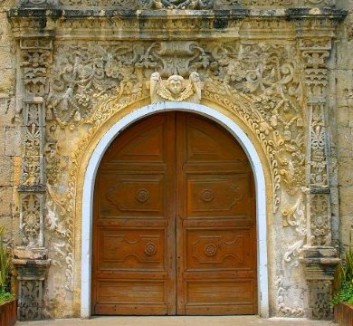 |
|
Since it’s likely that the work was done by Chinese stone masons and stone carvers, was it the friars who wanted add something stylish to their new church working in tandem with Chinese workers who may have been trained in Qing stonework which produced what we see today.The likely conclusion is that the Tigbauan stone carving is another fabulous multicultural amalgam of influences and skills which also produced the stone carving in Miagao and San Joaquin.
Below are a few photos, first of the Tigbauan façade and then of some other buildings in Spain and Mexico with carved stone entrances
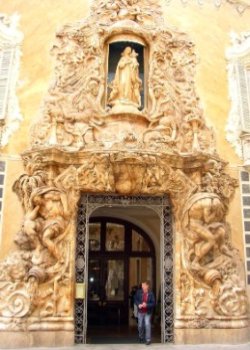 Palacio del Marqués de Dos Aguas in Valencia, Spain |  Tigbauan Church entrance |
If nothing else, the comparison shows is just how beautiful the Tigbauan church entrance is, even when compared to well-known international landmarks. Great credit goes to the Augustinian fathers and the residents of Tigbauan for creating this masterpiece and for their 250 years of stewardship of the church.
main altar
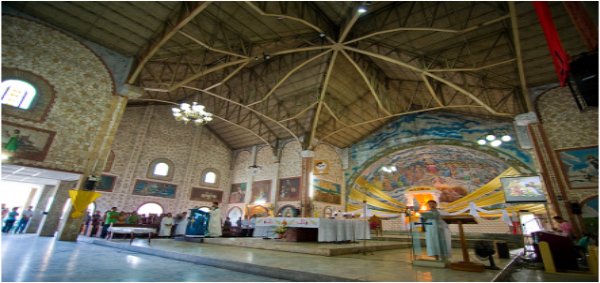
The church interior was gutted during the Second World War. Today, it has one of the most beautiful modern-type interiors made up of colorful stone murals. The mosaics adorning the church interior, including the altar and the Stations of the Cross, were created by a local artist in the last two decades.
interior mosaic walls
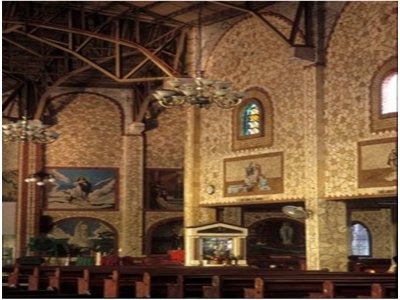 |
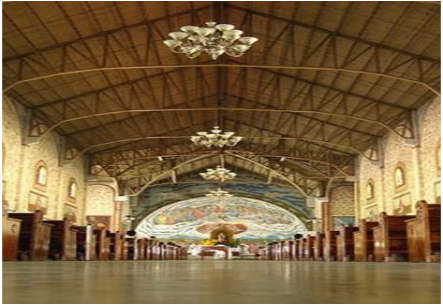
Tigbauan Church is one of the most beautiful heritage churches in Iloilo, best known for its Latin American and churique-inspired architecture. The church was built way back 1575, making it one of the oldest in the country. However, it was rebuilt when an earthquake struck in 1948, so not everything is original. Mosaics adorn the church’s interior, while imposing creations like the Stations of the Cross and the altar add to the magnificence of the structure.